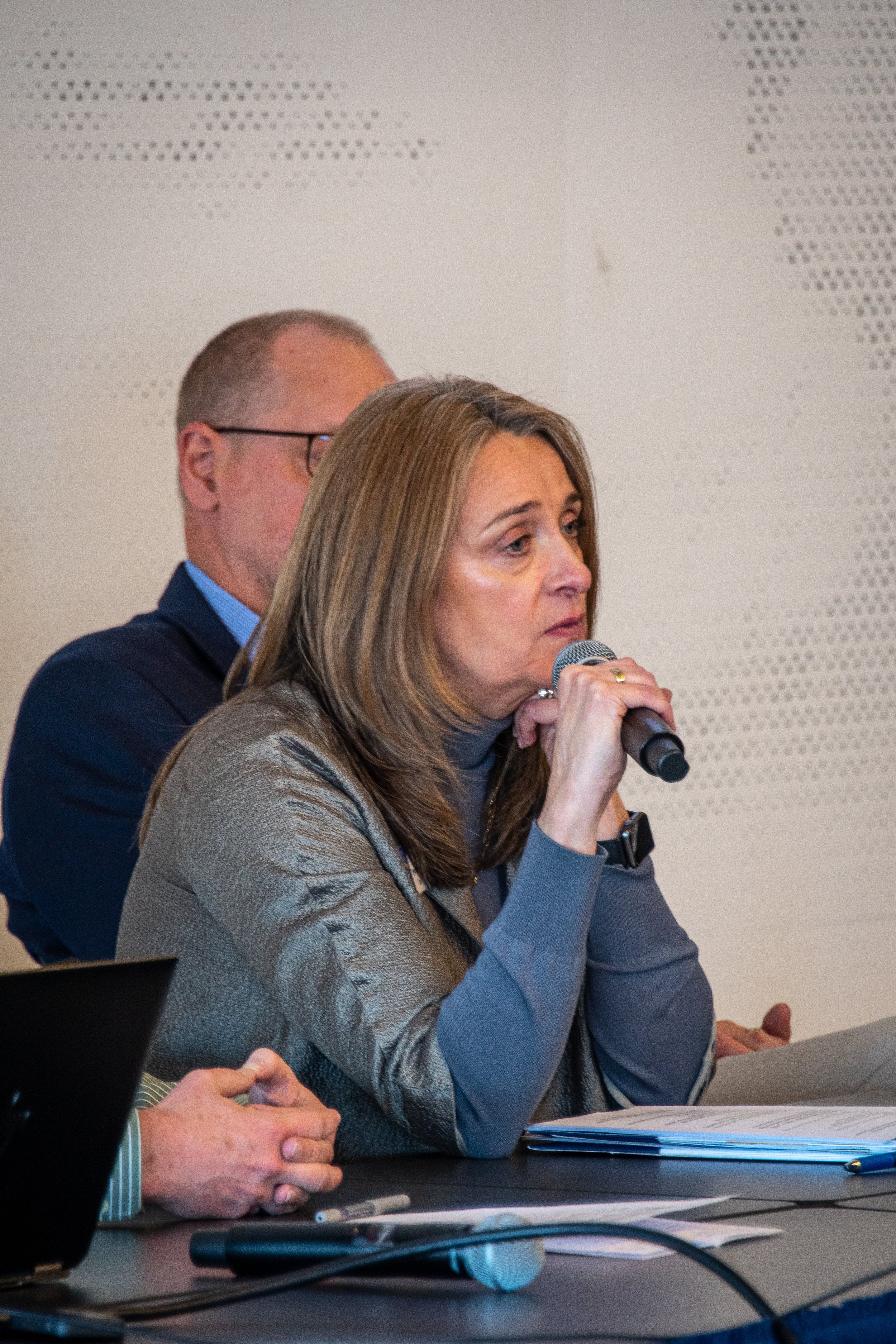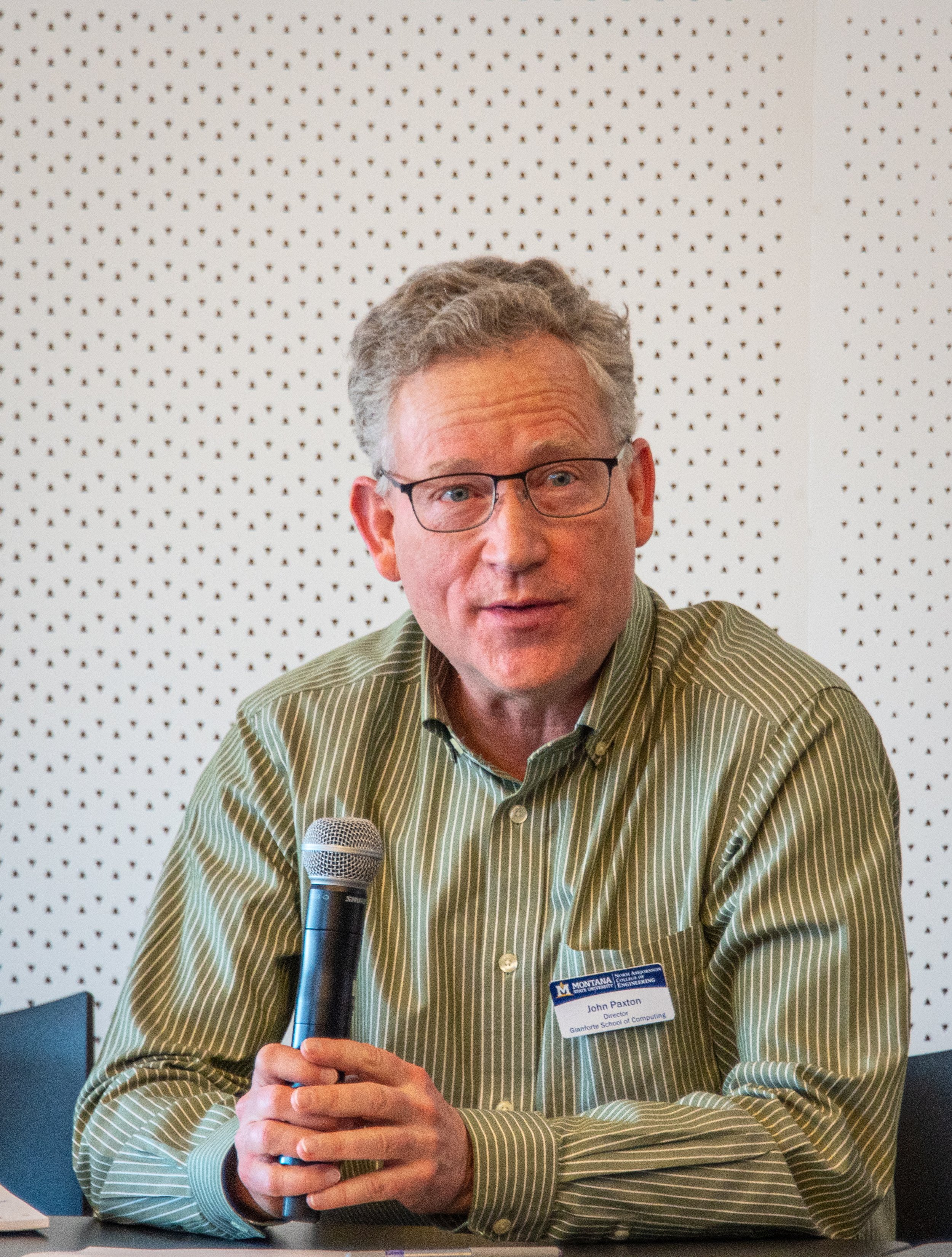MSU College of Engineering and Gallatin College MSU Expand Pathways to Tech Jobs
Jack Rumple, a volunteer from FIRST Robotics, demonstrates a robot for a student attending Engineer’s Week Events Hosted by the Montana High Tech Business Alliance and the Norm Asbjornson College of Engineering at Montana State University in Bozeman on February 23, 2022. Photos by 40Watt Photo.
By Courtney Brockman
June 8, 2022
Today’s students have an expanding variety of options to access tech and manufacturing career paths through Gallatin College MSU, the Gianforte School of Computing and the Norm Absjornson College of Engineering at MSU.
Three leaders from those institutions spoke on how higher education in the state provides a pipeline to tech jobs for students during the roundtable “A Vision for the Future of Technology Education in Montana” on February 23, 2022. The discussion was part of the Montana High Tech Business Alliance’s Engineer’s Week events hosted at the Montana State University Norm Asbjornson College of Engineering in Bozeman. The event drew more than 100 guests, including Governor Greg Gianforte.
Left to right: Tech Education panelists Stephanie Gray, Dean of Gallatin College MSU, John Paxton, Director of the MSU Gianforte School of Computing, and Brett Gunnink, Dean of the MSU Norm Asbjornson College of Engineering.
Gallatin College MSU in Bozeman Expands Workforce Pipelines in Photonics, Avionics, Welding, CNC Machining, IT Cybersecurity
Unique from other community colleges in that it is not a standalone school, Gallatin College works closely with MSU to offer classes for students earning four-year degrees as well as two-year applied science degrees. It also offers dual enrollment to high school students.
Sixty-four percent of Gallatin College’s students are part-time, and almost all are working while attending Gallatin College. With 73% of its students from Montana – 52% are from Bozeman and 21% from elsewhere around the state – Gallatin College offers programs allowing graduates to immediately enter the local workforce after gaining a full college experience, along with their technical skill attainment.
“Students like to have a college experience,” said Stephanie Gray, Gallatin College dean. “They get to come here, they live in the dorms, and work on a certificate or associates degree, and then return home to provide those services in their communities.”
In the past 10 years, Gallatin College MSU has steadily grown and increased its number of workforce programs from nine to 20, offering courses in everything from photonics to phlebotomy. Some of its most popular programs include IT cybersecurity, which creates professionals who can support the information security needs of businesses.
Gallatin College also has a CNC machining program, this prepares students to utilize special coding programs that direct machines to produce specific parts.
“If you go into into our labs, you'll see a list of probably 20 businesses that need our students right now,” Gray said. “And it ranges from people making guns to bows to parts for photonics companies - all kinds of really great products that are sold across the world. Another new program our CNC Director is developing is a robotics program.”
Beginning in this fall, Gallatin College will hold labs out at the airport for its new two-year avionics program in partnership with Bridger Aerospace. Avionics technicians are badly needed in the local workforce. Bridger Aerospace needed avionics technicians and made an investment with Gallatin College MSU to support the startup of this program and will also assist with providing lab space.
“I just want to challenge the notion that higher education does not adapt,” Gray said. “I think that we've demonstrated that we can adapt quickly.”
MSU’s Gianforte School of Computing Prepares for $50 Million Building Expansion, Adds Degree in Data Science
The Gianforte School of Computing, which grew out of MSU’s computer science department in the College of Engineering in 2016 and received $50 million in funding this year from the Gianforte Family Foundation for a new building, also seeks to funnel students into the local workforce.
The school has partnered with other campus departments to offer a broad range of degrees, such as a Bachelor of Arts in Computer Science for students with additional interests. One popular offering is a master’s, minor and soon-to-be bachelor’s degree in data science.
Currently, 200 students are a part of data science programs. John Paxton, School of Computing director, said one-sixth of the data science degree is electives so students may apply their knowledge to a specific area, such as collecting data from farm fields or low-producing conservation fields.
Data science applications can range from health care to manufacturing to construction trades.
“In today's world where everything from your smartphones to combines are generating lots and lots of data, putting that all together and trying to make sense of it has all sorts of applications and help in transportation, urban planning, and so on,” Paxton said.
The School of Computing also offers a teaching minor in Computer Science, as well as a master’s in cybersecurity. Currently 500 students on bachelor’s tracks are served through the school, 50 with masters or PhDs and 100 with minors.
MSU’s Norm Asbjornson College of Engineering Adds Environmental and Biomedical Engineering, Achieves Record Enrollment of Underrepresented Groups
The MSU Norm Absjornson College of Engineering also has rapidly grown, graduating one of its largest classes this past year and enrolling about 3,800 students. The college recently added environmental engineering and biomedical engineering along with its degrees in chemical, civil, electrical, computer, mechanical and industrial engineering. The College of Engineering also focuses on graduate education and research.
Many of the College of Engineering students come from Washington, California and Colorado. Paxton said most of the out-of-state students stay connected to the Montana workforce, with some ending up back in the state years after leaving.
“About half of our in-state people are working in Montana, about half left Montana,” Paxton said. “But about half of the out-of-state people are now working in Montana. So, these out-of-state students are definitely contributing to the in-state workforce.”
Dean Brett Gunnink said that educating the workforce is its goal, as well as engaging industry within the state of Montana. Increasing diversity and inclusion within the engineering field is also a priority.
“We have 25% women faculty in the College of Engineering, we have over 20% of female enrollment, and we’ve got record enrollments of other underrepresented groups, historically, in engineering education,” Gunnink said. “And I think that's important, when I reflect that back to what we're here for as a land grant university, which is to educate the sons and daughters of working-class America.”
Through developing and expanding on partnerships with companies like Boeing and Hyundai, the college also gives students opportunities to contribute to the local workforce.
“All of the expertise and knowledge and strength in the college is attractive to those companies that might potentially think about not only coming in and hiring graduates, but maybe leaving something here, opening an office,” Gunnink said.
Increasing Awareness of Tech Education Opportunities Among Students is Key to Future Growth
Despite the many tech and manufacturing career paths available, challenges remain in motivating students to choose them in the first place.
According to Gray, 40% of Montana high school students are not accessing higher education. There are hundreds of technical occupations across the state that this 40% of students could easily fill with a year or two of training in a certificate or an associate degree. Working together, industry and educators can help parents and students understand the value of these new technical occupations.
“The future is very bright for students that choose cyber security, photonics, avionics, or advanced manufacturing,” Gray said. “It is our job to make them aware they exist.”
Paxton said although the School of Computing has created two dual enrollment courses, many high school teachers do not have a technology background and miss the chance to better educate students on tech opportunities.
“They didn't really understand the potential about what it really involves and the problem-solving, the excitement, the ability to improve the world in which we live.” Paxton said.
While some states like Utah have invested in computer science and technology higher education, Montana also remains very underbudgeted, according to Paxton.
Educators hope ultimately more students will choose tech higher education through programs like FIRST Lego League and FIRST Robotics, which reaches out to youth with STEM learning, and Code Girls United, which provides fourth to eighth-grade girls in Montana year-round programming focusing on computer science.
“Going back to the outreach experience that we've had, a lot of it is just making sure that students while they're in the K-12 system have exciting, compelling exposure to high tech, so that if they do choose the steps to college or to go to a community college, this is on the radar of something that they might want to study,” Paxton said.
About the Publisher: Launched in 2014, the Montana High Tech Business Alliance is a nonpartisan nonprofit association of more than 200 high tech and manufacturing companies and affiliates creating high-paying jobs in Montana. For more information, visit MTHighTech.org or subscribe to our biweekly newsletter.
About the Author: Courtney Brockman is the former Communications Director for the Montana High Tech Business Alliance. She graduated from the University of Montana in 2017 with a degree in Journalism.







